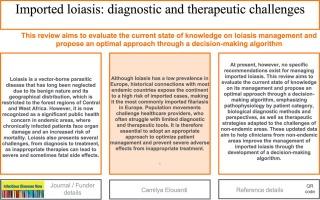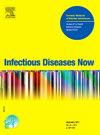输入性寄生虫病:诊断和治疗的挑战。
IF 2.2
4区 医学
Q2 INFECTIOUS DISEASES
引用次数: 0
摘要
Loiasis是一种媒介传播的寄生虫病,由于其良性性质和地理分布,长期以来一直被忽视,仅限于中非和西非的森林地区。然而,它现在被认为是流行地区的一个重大公共卫生问题,在那里,慢性感染患者面临器官损伤和死亡风险增加。从诊断到治疗,路易丝虫病带来了一些挑战,因为不适当的治疗可能导致严重的,有时甚至是致命的副作用。虽然丝虫病在欧洲的流行率较低,但与大多数流行国家的历史联系使该大陆面临输入病例的高风险,使其成为欧洲最常见的输入丝虫病。人口流动给医疗保健提供者带来了挑战,他们往往难以获得有限的诊断和治疗工具。因此,必须采取适当的方法,旨在优化患者管理,防止因治疗不当造成的严重不良反应。但是,目前没有关于管理输入性路易病的具体建议。本综述旨在评估其管理知识的现状,并通过决策算法提出最佳方法,强调按患者类别的病理生理学,生物学诊断方法和观点,以及适应非流行地区挑战的治疗策略。这些更新的数据旨在通过制定决策算法,帮助来自非流行地区的临床医生改善对输入性风疹病的管理。本文章由计算机程序翻译,如有差异,请以英文原文为准。

Imported loiasis: Diagnostic and therapeutic challenges
Loiasis is a vector-borne parasitic disease that has long been neglected due to its benign nature and its geographical distribution, which is restricted to the forest regions of Central and West Africa. However, it is now recognized as a significant public health concern in endemic areas, where chronically infected patients face organ damage and an increased risk of mortality. Loiasis presents several challenges, from diagnosis to treatment, as inappropriate therapies can lead to severe and at times fatal side effects.
Although loiasis has low prevalence in Europe, historical connections with most endemic countries expose the continent to a high risk of imported cases, making it the most commonly imported filariasis in Europe. Population movements challenge healthcare providers, who often struggle with limited diagnostic and therapeutic tools. It is therefore essential to adopt an appropriate approach aimed at optimizing to optimize patient management and preventing severe adverse effects due to inappropriate treatment.
At present, however, there exist no specific recommendations for managing imported loiasis. The present review aims to evaluate the current state of knowledge on its management and to propose an optimal approach through a decision-making algorithm, emphasizing pathophysiology by patient category, biological diagnostic methods and perspectives, as well as therapeutic strategies adapted to the challenges of non-endemic areas. These updated data aim to help clinicians from non-endemic areas to improve management of imported loiasis through development of a decision-making algorithm.
求助全文
通过发布文献求助,成功后即可免费获取论文全文。
去求助
来源期刊

Infectious diseases now
Medicine-Infectious Diseases
CiteScore
7.10
自引率
2.90%
发文量
116
审稿时长
40 days
 求助内容:
求助内容: 应助结果提醒方式:
应助结果提醒方式:


